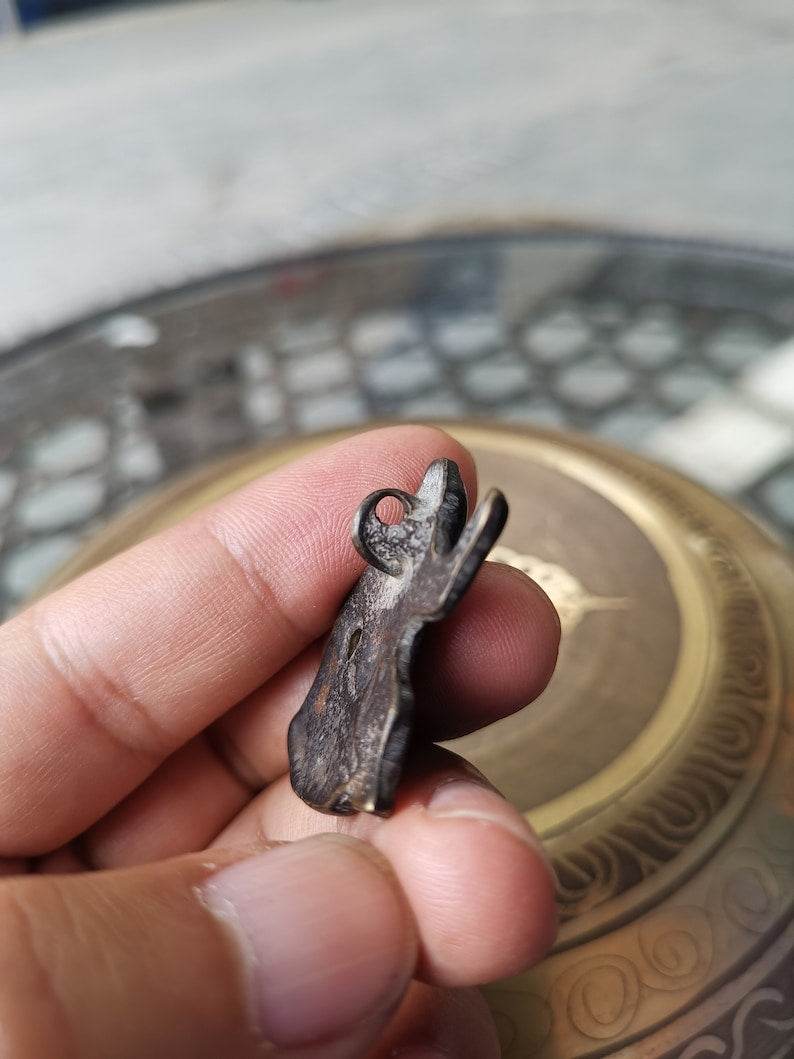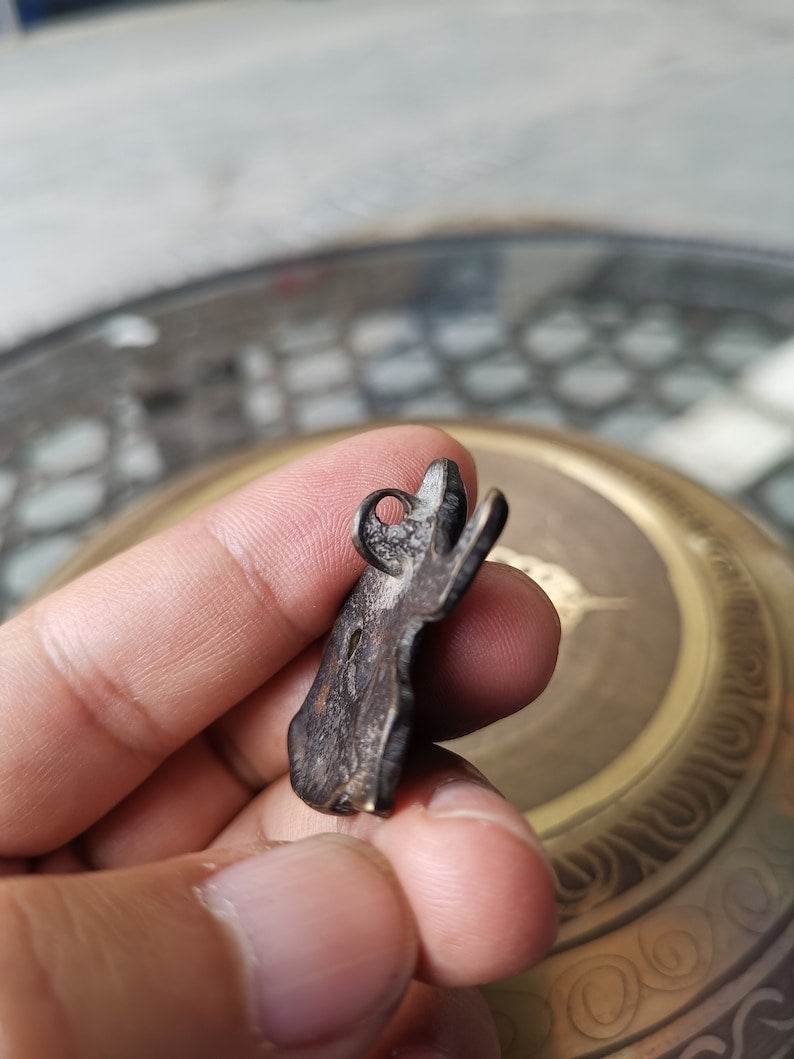Buddhist Protective Pendant,Abstract Wrathful Vajrapani Amulet Badge,Made of Thokcha,150 years old
Buddhist Protective Pendant,Abstract Wrathful Vajrapani Amulet Badge,Made of Thokcha,150 years old
Couldn't load pickup availability
This is collect from Kumbum Monastery Tibet,about 150 years old. It's an old badge or amulet pandent, made of thokcha (Cold Iron or meteoric iron),
It‘s shape is Wrathful Vajrapani,very abstract, representing the primitive and primitive Buddhist worship
You can make it into a pendant, or a keychain, or just put it on your desk,as an ornament.
Details
100% Handmade
Pendant material:copper
Pattern: Wrathful Vajrapani
Length: 35mm /1.37 inches
Width: 35mm /1.37 inches
Weight:14g / 0.5oz
ABOUT Thokcha -Thunder Iron
Thokcha (Tibetan: ཐོག་ལྕགས, གནམ་ལྕགས) are tektites and meteorites which serve as amulets.Typically high in iron content, also called Thunder Iron,Cold Iron.These are traditionally believed to contain a magical, protective power comparable to Tibetan dzi beads. Most thokcha are made of a copper alloy.
Thogchags or Thokcha are worn as amulets by Tibetans, specifically people of the Himalayan regions, for spiritual protection and healing. Created in several forms, they often depict tantric deities, sacred animals, auspicious symbols, and mantras. Many represent ritual supports such as a mirror, phurba, or vajra. Some pieces may be abstract in nature, and the meaning of the form has since been lost in antiquity. Further research is still in the process. Other Thokcha were simply used as ancient arrow points, buckles, body armour, or even old horse trappings.
ABOUT VAJRAPANI
Vajrapāṇi (Sanskrit; Pali: Vajirapāṇi, meaning, "Vajra in [his] hand") is one of the earliest-appearing bodhisattvas in Mahayana Buddhism. He is the protector and guide of Gautama Buddha and rose to symbolize the Buddha's power.
Meaning
Vajrapāni is seen as a manifestation of Vajradhara and the "spiritual reflex", the Dhyani Bodhisattva of Akshobhya.On the popular level, Vajrapāni is the bodhisattva who represents the power of all the buddhas just as Avalokiteśvara represents their great compassion, and Mañjuśrī their wisdom.He is called the Master of Unfathomable Mysteries who upholds truth even in adversities of darkness and ignorance.
Vajrapāni is extensively represented in Buddhist iconography as one of the earliest three protective deities or bodhisattvas surrounding the Buddha. Each of them symbolizes one of the Buddha's virtues: Manjushri manifests all the Buddhas' wisdom, Avalokiteśvara manifests all the Buddhas' immense compassion, and Vajrapāni protects Buddha and manifests all the Buddhas' power as well as the power of all five tathāgatas (Buddhahood of the rank of Buddha).
Vajrapāni is one of the earliest Dharmapalas of Mahayana Buddhism and also appears as a deity in the Pali Canon of the Theravada school. He is worshiped in the Shaolin Monastery, in Tibetan Buddhism and in Pure Land Buddhism (where he is known as Mahasthamaprapta and forms a triad with Amitābha and Avalokiteśvara). Manifestations of Vajrapāni can also be found in many Buddhist temples in China, Taiwan and Japan as Dharma protectors guarding monastery and temple gates. Vajrapāni is also associated with Acala, where he is serenaded as the holder of the vajra.
Forms
In human form Vajrapāni is depicted holding the vajra in his right hand. He is sometimes referred to as a Dhyani-Bodhisattva, equivalent to Akshobhya, the second Dhyani Buddha. Acharya-Vajrapani is Vajrapani's manifestation as Dharmapala, often seen sporting a third eye, ghanta (bell) and pāśa (lasso). He is sometimes represented as a yidam with one head and four hands in a form known as Nilambara-Vajrapani, carrying a vajra, and treading on personage lying on snakes. Mahacakra-Vajrapani, also a yidam, is depicted with three heads and six arms, carrying a vajra and snakes whilst treading on Brahma and Shiva. He is often in union with his consort in yab-yum. Acala-Vajrapani is depicted with four heads, four arms and four legs carrying a sword, a lasso and vajra, treading on demons. Another depiction is in the form with the head, wings, and claws of Garuda.
Vajrapāni's expression is wrathful, and is often symbolized as a yaksha, to generate "fear in the individual to loosen up his dogmatism." His outstretched right hand brandishes a vajra, "symbolizing analytical knowledge (jñanavajra) that disintegrates the grasping of consciousness Although he sometimes wears a skull crown, in most depictions he wears a five-pointed bodhisattva crown to depict the power of the five Dhyani Buddhas (the fully awakened state of the Buddha).
Parinirvana of Buddha.
In early Buddhist legends, Vajrapāni is a minor deity who accompanied Gautama Buddha during his career as a wandering mendicant. In some texts he is said to be a manifestation of Śakra, king of the Trāyastriṃśa heaven of Buddhist and Hindu cosmology and god of rain as depicted in the idols of the Gandharva. As Śakra, it is said that he was present during the birth of Tathagata. As Vajrapāni he was the god who helped Gautama escape from the palace at the time of his renunciation. When Sakyamuni returned from Kapilavastu he is stated to have assumed eight forms of devas who escorted him.
According to Xuanzang, the Chinese monk and traveler, Vajrapāni vanquished a large serpent at Udyana. In another version it is stated that while the Nāgas came to worship the Buddha and hear his sermons, Vajrapāni assumed the form of a bird to deceive them so that they were not attacked by their deadly enemies, the Garudas.
At the parinirvana of the Buddha, Vajrapāni dropped his vajra in despair and rolled himself in the dust.
According to the Pañcaviṃsatisāhasrikā- and Aṣṭasāhasrikāprajñāpāramitās, any bodhisattva on the path to buddhahood is eligible for Vajrapāni's protection, making them invincible to any attacks "by either men or ghosts".
ABOUT GANDHANRA
We're artisans from Hepo Township, Baiyu County,Tibetan.
We use ancient Tibetan handicrafts to make Tibetan Buddhist instruments.
All our crafts are directly handmade from Tibet.
When you purchase this craft it helps and support our artisan and our families in Tibet.
Your support is highly appreciated.
Packaging &Shipping:
As per our Product nature, we do the packaging. For every single product, we do the bubble wrapping along with the paper carton boxes is also used for more safety. In the case of heavy products, we also use wooden boxes too for more safe packaging and sent for the shipping process.
Feedback:
Our goal is to make sure my customer is happy and satisfied when you shopping with us. Please contact or email before leaving negative feedback.
We will try out best to solve our issues. Please give us the chance to resolve any problem.
Notice:
1.Please allow 1-2mm error due to manual measurement.
2.The color may have different as the difference display.
3.Please make sure you do not mind before you bid.
THANK YOU FOR purchasing our product.












